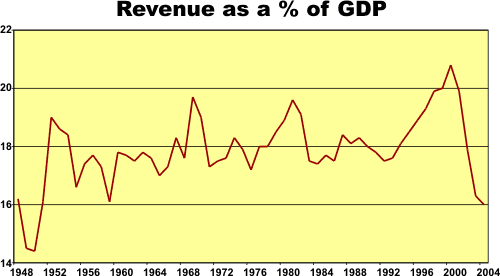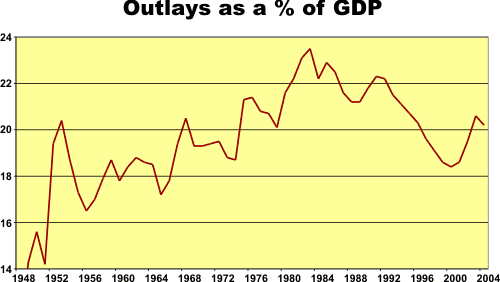
The Deficit As a Serious Problem
by Guest Blogger, 10/6/2003
Like the Reagan administration, the Bush administration continues to describe the budget deficit as a manageable problem and presents a rosy picture in which deficits will soon diminish. But like the Reagan administration these comments are far from reality.
Like the Reagan administration, the Bush administration continues to describe the budget deficit as a manageable problem and presents a rosy picture in which deficits will soon diminish. But like the Reagan administration these comments are far from reality.
The Congressional Budget Office (CBO) has estimated that the deficit for this year (FY 2003) will be $401 billion and $480 billion next year, the highest ever in dollar terms. These numbers could go up if the President’s $87 billion request for Iraq is approved. The administration argues that in an economy as large as ours, these numbers are not a significant problem. Translated as a percentage of the Gross Domestic Product, it would be 3.7% and 4.3%, respectively. While these figures are slightly lower than several years during the Reagan administration, they still are far higher than is acceptable. In fact, when deficits reached 4% of GDP in the 1980s, Congress, the public, and news media became very focused and concerned about deficits.
To make matters worst, the deficit is actually much greater than what the CBO numbers tells us. For example, the deficit adds together the “on-budget” (e.g., controllable) and “off-budget” (e.g., Social Security) surplus/deficits. If you exclude Social Security from the calculations, the deficit is actually estimated to be at least $644 billion in FY 04 and, according to Sen. Kent Conrad (D-ND), 6.2% of GDP or the highest since the end of World War II.
In addition, more realistic estimates of the deficit point to a $5 trillion cumulative deficit over the next 10 years, according to a bipartisan group of prominent budget analysis organizations.
Why is the deficit soaring? There are many explanations, but two points should be clear. First, revenue, as a percentage of GDP, is declining. Our revenue, projected to be 16% of GDP in 2004, will be at the lowest level since 1950 when it was 14.4%. (See chart below.) If Social Security were excluded, it would be far lower than the 1950s.
Second, spending, as a percentage of GDP, is at a lower level than any point between 1979 and 1996, projected to be 20.2% in FY 04. (See chart below.) Generally, spending as a percentage of GDP has been declining since 1992. This is even more pronounced if Social Security is excluded.
According to CBO, in FY 03, 92% of increased discretionary spending (above a baseline) has been in three areas: defense, homeland security, and rebuilding New York and providing airline relief. Other domestic spending has either been stable or decreased.
The point is that unless this country has a stronger revenue base, we cannot sustain existing spending priorities. The solution is not to cut spending any further, but to restore revenue to historically reasonable levels.




